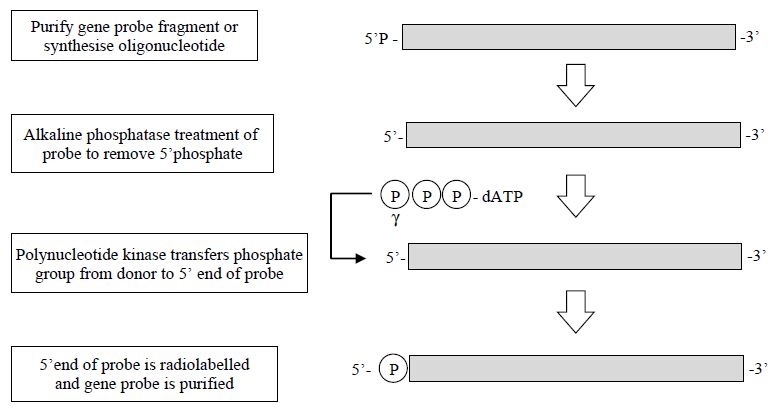


 النبات
النبات
 الحيوان
الحيوان
 الأحياء المجهرية
الأحياء المجهرية
 علم الأمراض
علم الأمراض
 التقانة الإحيائية
التقانة الإحيائية
 التقنية الحيوية المكروبية
التقنية الحيوية المكروبية
 التقنية الحياتية النانوية
التقنية الحياتية النانوية
 علم الأجنة
علم الأجنة
 الأحياء الجزيئي
الأحياء الجزيئي
 علم وظائف الأعضاء
علم وظائف الأعضاء
 الغدد
الغدد
 المضادات الحيوية
المضادات الحيوية|
Read More
Date: 15-5-2016
Date: 3-12-2015
Date: 2-4-2021
|
End Labelling of DNA Molecules
The simplest form of labelling DNA is by 5´ or 3´ end labelling; 5´ end labelling involves a phosphate transfer or exchange reaction where the 5´ phosphate of the DNA to be used as the probe is removed and in its place a labelled phosphate, usually 32P, is added. This is usually carried out by using two enzymes; the first, alkaline phosphatase, is used to remove the existing phosphate group from the DNA. Following removal of the released phosphate from the DNA, a second enzyme, polynucleotide kinase, is added, which catalyses the transfer of a phosphate group (32P-labelled) to the 50 end of the DNA. The newly labelled probe is then purified, usually by chromatography through a Sephadex column, and may be used directly (Figure 1).

Figure 1. The steps involved in the production of a 5´-labelled gene probe.
Using the other end of the DNA molecule, the 3´ end, is slightly less complex. Here a new dNTP which is labelled (e.g. [32P]adATP or biotinlabelled dNTP) is added to the 3´ end of the DNA by the enzyme terminal transferase. Although this is a simpler reaction, a potential problem exists because a new nucleotide is added to the existing
sequence and so the complete sequence of the DNA is altered, which may affect its hybridisation to its target sequence. End labelling methods also suffer from the fact that only one label is added to the DNA so they are of a lower activity in comparison with methods that incorporate label along the length of the DNA (Figure 2).

Figure 2. The steps involved in the production of 3`-labelled gene probe.



|
|
|
|
لصحة القلب والأمعاء.. 8 أطعمة لا غنى عنها
|
|
|
|
|
|
|
حل سحري لخلايا البيروفسكايت الشمسية.. يرفع كفاءتها إلى 26%
|
|
|
|
|
|
|
جامعة الكفيل تحتفي بذكرى ولادة الإمام محمد الجواد (عليه السلام)
|
|
|